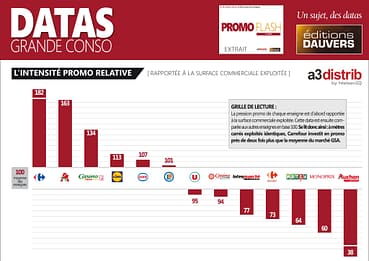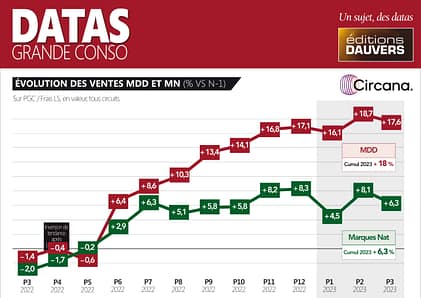
Use case: the pricing in times of inflation
The economic climate of recent months has been turbulent, and in question, inflation! Geopolitical, health and environmental shocks have had a direct impact on the economic health of our businesses. The steady rise in raw material and purchasing costs has pushed inflation up to more than 15% in some sectors.
Today relatively stabilized but still well above average (between 5 and 6%), inflation remains a major issue to manage for our companies to ensure their profitability.
This use case aims to highlight the relevance of using a pricing tool to meet the many challenges created by inflation.
Manage changes in purchase prices
Fluctuations in raw material costs have a direct impact on suppliers who have to adjust their prices. Thus, we are witnessing a multiplication of rounds of negotiations between brands and their suppliers. It is becoming increasingly difficult to manage the frequency of purchase price changes: retroactive negotiations, internal delays in updating long prices, etc.
To manage this challenge and control potential losses, retailers can equip themselves with a pricing tool to automate the recalculation of prices following the update of purchase prices. In addition, in order to circumvent the problems related to the process delays of the automatic price update, on PricingHUB, it is also possible to import the purchase prices manually to adapt more quickly.
One of the many challenges exacerbated by increases in purchase prices for retailers is the distribution of losses across all shelves. In addition to the automation of business impact simulation calculations offered by a tool, this distribution can be refined through the use of consumer price sensitivity (elasticity). The knowledge of price elasticity, allows you to judiciously segment your product catalog in order to determine or increase prices by minimizing the volume impact and to maintain low prices on products with high potential vector of the price image. Working on this segmentation makes it possible to intelligently distribute the losses related to the increase in purchase prices.
Enable fine product segmentation
As mentioned earlier, it is essential to segment your product catalog in a granular way. In inflationary times, consumers see their purchasing power decrease and therefore tend to pay more attention to their spending. It is therefore essential to be able to determine the commodities on which it is important to maintain a stable price and the contributing products, more volatile, on which it is possible to vary your prices and maintain your profitability. Many supermarket chains have identified this issue and now offer “anti-inflation baskets” with blocked prices.
Our expertise on price elasticity allows us to offer a tool allowing you to set up a fine and granular product segmentation on which it is possible to isolate the “anti-inflation baskets” and distribute margins throughout your catalog. In addition, a tool like PricingHUB can allow you to meet these challenges through the use of a multi-attribute rules engine (eg product segmentation, elasticity segmentation, product attribute, stock turnover indicator).
Adapt quickly to contextual changes
Competition
Inflation impacts not only your trading cycles but also your price index. These contextual changes can therefore have an impact on your place in the market against the competition. It is therefore essential to protect yourself and ensure that you stay close to your direct competitors.
A pricing tool allows you to automatically adjust to the price changes of your competitors but also to take into account the specificities that may exist locally. This allows you to define specific adjustments based on the competition per catchment area.
It is therefore essential to opt for a dynamic strategy of updating prices while keeping in mind certain existing constraints such as ELS. To meet this need, our solution offers a prioritization of price recommendations to select a defined number of price changes per day or week, according to your constraints.
Consumer price sensitivity
The decline in consumers’ purchasing power tends to change their purchasing behavior. Indeed, several studies have been conducted in recent months and all are unanimous: consumers have changed their habits.
Specials
A French study by PWC highlights the attractiveness of promotions for nearly half of consumers: they allow them to remain loyal to their favorite brands while protecting their purchasing power. Retailers have different strategies for offering promotional offers to consumers. To meet this challenge, our tool offers a promotional optimization module.
Quarterly Promo-Flash study by Dauvers editions
Private label product
Nearly 30% of consumers intend to buy more private label products (PWC study). Unlike promotions, this change of habit implies a descent into the range for the consumer who wants to reduce his expenses. In this context, it is essential to have a good consistency of range on your shelves and to chain your private label with national brand products. You can use the chaining rules on our tool to do granular work and automate the resulting price adjustments.
Loyalty programs
Finally, according to this study, 36% of consumers will tend to turn to distributors offering better value for money. In this context, loyalty programs take on their full meaning. Our tool offers a double price recommendation, and allows you to automatically calculate the recommended price for cardholders according to the criteria of generosity.
In general, when it comes to consumer price sensitivity, in order to adapt quickly to possible changes, retailers can implement pricing strategies based on price elasticity in order to compensate for potential losses. Our artificial intelligence tool leverages price elasticity while protecting consumers’ price sensitivity through granular price optimization.
To conclude, a pricing tool is relevant in the current situation on both aspects.
Adaptability + Responsiveness + Segmentation + Granularity = More commercial efficiency
But not only!
Control your price image
Indeed, a too abrupt change in pricing strategy can negatively impact a company’s price image and deter consumers from buying its products. The Casino brand has also suffered. The company has implemented an optimization of its pricing however the price changes were too abrupt and high on some basic products and were identified by consumers which created a bad buzz ( link to the article ).
In times of inflation, we recommend controlled price changes to adjust to consumer price sensitivity that is undermined by inflation. This complex subject, because subjective, was the subject of a workshop at the PricingHUB Day in June 2022 whose conclusion is that the usability of price image optimization is done through multiple factors; the price as such is only a component whose weight is relatively low.
Discover our tool with one of our experts, make an appointment right here !




